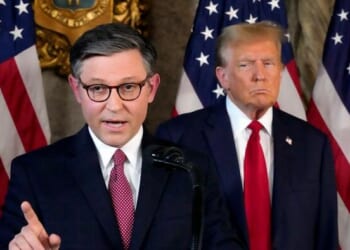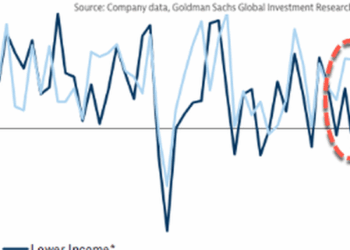By Michael Every of Rabobank
Today has an embarrassment of riches in news; and a poverty of takes of how it all links together.
Bloomberg claims the ‘’Widow-Maker’ Trade Becomes World Beater as Japanese Bonds Sink’. The 2025 trend in JGB yields, if now off recent highs, shows a generational shift taking place, which could accelerate following the emergence of Takaichi as PM.
- Similar worries remain from the US to “Où sont my crown jewels?” France to EM, even if yields moved lower yesterday on safe-haven bids as the global internet wobbled.
After Trump told President Zelenskyy to make a peace deal or be “destroyed” by Russia, which is close to calling up another 2m men to fight, Zelenskyy tried to paint their meeting as “positive.” The EU is still seeking to secure the use of Russian assets for Ukraine and more sanctions on Moscow: yet the White House is stalling a G7 plan for the former and the Senate just paused its Russia Sanctions Bill.
- Again, the US is aiming for a Noxin (reverse Nixon) deal or a war freeze: Europe wants more, but doesn’t seem willing to pay up, and just agreed to phase out Russian oil purchases by January 2028, meaning it will fund attacks on Ukraine for another two years.
Politico also notes ‘Here comes the EU’s first anti-far-right European Council’, arguing “Housing, social media regulation, migration, and defence spending are all being used by the political mainstream to curb the march of populism” – but doesn’t that all sound populist? The same press also says ‘New EU members could join without full voting rights’: really?
- Europe’s internal flux matches its immediate external environment – it’s not business as usual.
In the Middle East, Iran’s Khamenei rejected a Trump offer of talks, again, and denied that the US had destroyed Iranian nuclear capabilities. Is that playing with fire on top of a lot of oil? Trump also floated a renewal of Gaza fighting, but said Hams still has chance to “behave”, as and VP Vance heads to Israel today as part of efforts to shore up the ceasefire.
- Overall, momentum continues to build towards a new Middle East where oil stays firmly priced in US dollars.
In LatAm, Argentina’s peso weakened despite the US officially agreeing a $20bn swapline as the Wall Street Journal reported ‘US Banks Are Hunting for Collateral to Back $20bn Argentina Bailout’ (WSJ) such as “assets or guarantees from the US that would back a private-sector loan to support Argentine President Javier Milei” – recall Argentine elections are this Sunday; Bolivia elected centrist Rodrigo Paz as president, ending decades of socialist rule, and restarting relations with the US after 20 years; ‘Trump doubles down on Colombia crackdown, calls Petro ‘lunatic,’ vows to end all US payments over drugs’, as Fox news put it, with a new, higher US tariff rate on Colombia due imminently; and another Venezuelan narco-boat was hit by the Pentagon.
- In short, there’s more Monroe than in ‘Some Like it Hot’ – and things could get hot as the US reasserts its role in the Western hemisphere while pushing Chinese, Russia, and Iranian influence out.
In the Asia-Pacific, Trump backed the AUKUS defence deal and will push to expedite nuclear sub deliveries. The US Navy Secretary wants to clear up some of the “ambiguity”, so AUKUS is a “win-win for everybody.” In parallel, ‘‘We’ll have so much’: Trump taunts China with Albanese rare earths deal’ (AFR), as the White House struck a supply deal and claimed Australia will invest $1 trillion in the US by 2035 via its superfunds.
- Is there any need for discussion on whose side Oz has chosen, geopolitically? However, one wonders if this will soon involve it spending 5% of GDP on defence, and/or necessitate a Fed swapline, as South Korea has floated?
Trump expects to discuss Taiwan when he meets Xi, and while he predicts a trade deal, he made clear the extra 100% China tariff will hit if Beijing won’t buy US soybeans and sell it rare earths… exports of which just slumped in data released yesterday. USTR Greer also stated China is trying to pressure foreign firms from investing in the US to disrupt supply chains, mentioning shipbuilding in particular, but “Intimidation won’t stop us from rebuilding.” Indeed, as the US Supreme Court was told ‘Trump tariffs are an illegal $3 trillion tax’, the New York Times notes ‘Hundreds of Korean Workers Were Detained by ICE. Hyundai is Not Deterred’, and that new factories really are springing up, while the White House said the $100,000 H-1B visa fee will be paid by applicants living abroad.
- Is this “because markets” messaging that screams ‘trade deal’?
The Financial Times meanwhile takes a strong editorial stance today (‘The boardroom bet on Trump’s industrial policy’) and argues “CEOs would be wise to avoid staking too much on the US president’s pet projects” because Biden’s IRA was reversed and China is seeing deflation due to too much production – as if that’s a current US problem!
On the other hand, China’s key fourth plenum continues. The Xinhua media release note: “Standing at a new historical starting point, let us unite more closely around the Party Central Committee with Comrade Xi Jinping at its core, comprehensively implement Xi Jinping Thought on Socialism with Chinese Characteristics for a New Era, inspire a spirit of striving for every minute and never slacking off, and gather the tremendous strength of unity and courage to forge ahead. We will work towards a blueprint that will be followed through to the end, generation after generation…”
- Is this “because markets” messaging that screams ‘trade deal’?
Also of note after yesterday’s Chinese GDP data, the South China Morning Post yesterday asked: “As China drafts its next 5-year plan, is GDP still the magic number?” where “With the fourth plenum set to outline China’s long-term plans, analysts consider more benchmarks than GDP for ‘high-quality development’ era”. When even China is starting to ask, ‘What is GDP *for*?’ rather than just “4.9% or 5%?”, it underlines how out-of-the-loop most “because markets” Western thinking and analysis still is.
Relatedly, the SCMP also says ‘China’s AI plan offers citizens ‘infinite hope’ with robot companions and kids by 2035’ – “But a Chinese expert warns it could lead to mass unemployment, polarisation, reduction in marriage rates and ‘erosion of family ethics’”. The West doesn’t seem to be offering its citizens much hope in some eyes, let alone ‘infinite’, and it can’t even agree on how to use AI and industrial robots in its factories yet, let alone in relationships.
- Who does this suggest is ahead, and behind. in this critical geoeconomic area? And beyond ‘buy all the things!’ aiming for an embarrassment of riches, is this disruptive trend inflationary or deflationary, or both – and what do we do about changes to society on this scale at this kind of speed? We have an absolute poverty of takes on this in particular.
Loading recommendations…

















